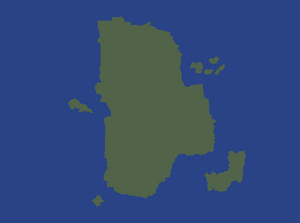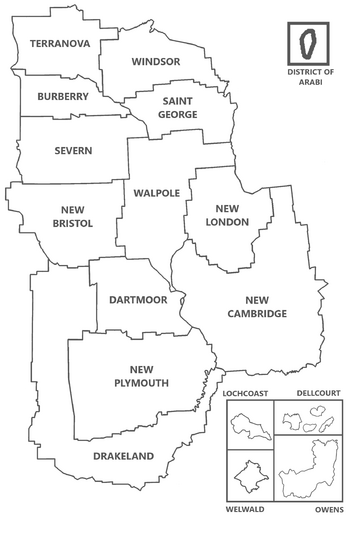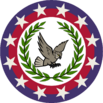Arabi
United Socialist States of Arabi | |
|---|---|
| Motto: "Libertatem liberam non" (Latin) "Freedom is not free" "Praeterita meminisse, vivant in praesenti et futuro imaginari" (Latin) "Remember the past, live in the present and imagine the future" | |
 Satellite Map | |
States of Arabi (Click an area on the map for information about that state) | |
| Capital | District of Arabi |
| Largest city | Old Clark City |
| Official languages | None at federal level |
| National language | |
| Demonym(s) | Arabinian |
| Government | Federal democratic presidential constitutional republic |
| Lona Freeman (D) | |
| Melissa Hewitt (D) | |
| Chelsea Pickering (D) | |
| Audra Sanchez | |
| Legislature | Congress |
| Senate | |
| House of Representatives | |
| Autonomy from Great Britain | |
• Independence | August 20, 1837 |
| May 16, 1838 | |
| August 9, 1931 | |
| Area | |
• Total | 166,929 km2 (64,452 sq mi) |
• Water (%) | 12.65 |
| Population | |
• 2020 census | |
| Currency | Arabin Dollar (AD) |
| Time zone | AST |
• Summer (DST) | ADT |
| Date format | mm/dd/yyyy yyyy/mm/dd |
| Driving side | right |
| Calling code | +1 |
Arabi, officially the United Socialist States of Arabi (USSA), also known as the United Socialist States (U.S.S or USS), is a country comprising of 16 states, 12 of which are contiguous, 4 are located on islands surrounding the mainland (one of which is an archipelago), and a federal district. As of 2020, the population was 66,384,207. The capital is District of Arabi and the most populous city is Old Clark City. The country is located on the Arabin islands located in the Atlantic Ocean near the eastern coast of North America.
The current president is Lona Freeman who was elected on December 1, 2018.
History
Discovery by Vikings and British settlements (1001; 1538-1553)
The Arabin islands were first discovered in the year 1001 by Leif Erikson. After landing on the island Erikson and his crew came across a variety of different dangerous animals. Erikson noted that the island would be inhabitable to humans and advised other explorers to not visit the island. After five centuries British explorers arrived on the island in 1538. After arriving, the explorers noticed a majority of the dangerous animals had died off. In 1545, King Henry VIII of England sent colonizers to the island to inhabit the island. By 1546, five British colonies were established. The colonies were called; New London, Windsor, Terranova, New Cambridge, and New Plymouth.
With the death of Henry VIII, his son, Edward VI of England, became King in 1547. However, Edward’s reign was short-lived when he died in 1553 at the age of 15. After Edward died, his half-sister Mary I of England became Queen.
Petition for autonomy (1557-1615)
Queen Mary, like her half-brother, only reigned for a short amount of time before her death in 1558. Many of Mary’s opponents dubbed her ‘’’Bloody Mary’’’ for the 280 religious dissenters she had burned at the stake. Unlike the two previous monarchs, Mary never visited the Colonies of Arabi. She believed the colonists should be thrown in jail for their opposition to her as Queen. In 1557, Mary has sent an armed militia to the island with the orders to kill as many as possible. However, the ships never made it to the island and it was presumed to have sunk in the Atlantic Ocean.
When Mary died on November 17, 1558, her half-sister Elizabeth I of England became Queen. On December 15, 1558, Elizabeth’s first trip, as Queen, was to the Arabin Colonies. While she was there, she officially apologized on behalf of the crown for the treatment they experienced with the previous monarch. During her trip, the New London Colony Governor, petitioned Elizabeth to grant full autonomy to the colonies. The petition was signed by all of the governors. Elizabeth met with all of the governors to discuss granting autonomy. After three days of discussions, they could not come to an agreement.
In 1580, Elizabeth signed a declaration granting the colonies partial autonomy, allowing them to make any laws they wanted but they had to be approved by the monarchy. While some colonists were happy with this declaration, others were upset still being under the rule of the crown. Over the next ten years, the governors of the colonies continuously petitioned Elizabeth to grant full autonomy to no prevail.
When Elizabeth died in 1603, she had no heir to the throne, therefore, the House of Tudor ceased to exist. Which gave rise to the House of Stuart with the first monarch being James VI and I of Scotland and England & Ireland, respectively.
The colonists petitioned James to visit the colonies and discuss granting them full autonomy. James visited the island in 1615. When he met with the governors of the colonies they came to an agreement. James and the governors signed a proclamation that would grant the colonies full autonomy in 150 years. All of the governors agreed on the proclamation.
English Civil War (1642-1655)
On March 27, 1625, Charles I became the monarch of England, Scotland, and Ireland until his execution on January 30, 1649. During Charles’ reign, the English Civil War occurred. The first (1642-1646) and the second (1648-1649). The war was a series of armed conflicts and political machinations between Parliamentarians and Royalists over, principally, the manner of England’s governance. The wars pitted the supporters of King Charles I against the supporters of the Long Parliament, while the third (1649-1651) saw fighting between supporters of King Charles II and supporters of the Rump Parliament. The overall outcome of the war was threefold: the trial and execution of Charles I (1649); the exile of his son, Charles II (1651); and the replacement of English monarchy with, at first, the Commonwealth of England (1649-1653) and then the Protectorate under the personal rule of Oliver Cromwell (1653-1658)) and subsequently his son Richard (1658-1659).
In 1655, Oliver Cromwell declared, “the proclamation to grant full autonomy to the Arabin Colonies is terminated and will remain under the control of England indefinitely.”
Restoration of the English monarchy (1658-1685)
A political crisis that followed the death of Oliver Cromwell in 1658 resulted in the restoration of the monarchy and after nine years in exile, Charles II was invited to return to Britain. On May 29, 1660, he officially became King of England. Charles was one of the most popular and beloved kings of England, especially in the Colonies of Arabi because he reinstated the proclamation to grant them full autonomy, which had been terminated in 1655 by Oliver Cromwell.
Charles died on February 6, 1685 and was succeeded by his brother James II.
Additional colonies established (1662 & 1717)
In 1662, three colonies were established on the island made up of land previously used by the other five colonies. The colonies established were; Dartmoor, New Bristol, and Severn. Dartmoor is named after a National Park in England; New Bristol is named after the city and county in South West England; Severn is named after the longest river in Great Britain.
In 1717, four additional colonies were established on the island made up of land that was being used by the other eight colonies. The colonies established were; Burberry, Saint George, Drakeland, and Walpole. Burberry is named after George Burberry, an advisor to King George I, who was the monarch when the colony was established; Saint George is named after the saint himself; Drakeland is named after Francis Drake, who was an English naval officer; and Walpole is named after Robert Walpole, who was the first Prime Minister of Great Britain.
King George III reign (1760-1837)
On October 25, 1760, George III became the King of the United Kingdom of Great Britain. The proclamation for full autonomy was supposed to occur during George’s reign, however, one day after becoming king, he terminated the proclamation. He declared, like Cromwell, “the Arabin colonies would never be granted full autonomy and would remain under control of Great Britain.”
George’s reign was very controversial, mainly due to the unfair treatment of the Thirteen British American Colonies, which resulted in the American Revolutionary War which lasted from 1775-1783.
Towards the end of George’s reign suffered from mental illness. It has since been suggested that he had bipolar disorder or porphyria.
After George’s death, his son, George IV, became king on January 29, 1820. During his ten-year reign, he never spoke of the terminated proclamation despite many petitions to be granted full autonomy. When he died on June 26, 1830, his younger brother, William IV became king.
During William’s reign, like his older brothers, did not mention the proclamation. He died on June 20, 1837, his niece, Victoria succeeded him and became Queen.
Second restoration and full autonomy (1837)
Two months into Victoria’s reign, on August 20, 1837, she declared that she would grant full independence to the Arabin Colonies effective immediately.
Constitution, ratification, and date effective (1838-1839)
All twelve colonies on August 20 became fully independent, after two months of gathering by political leaders, the Constitution of Arabi was created on September 27, 1837 and was presented on September 23, 1837. Only eight out of the twelve colonies needed to ratify the constitution for it to be the supreme law of the new country. By May 16, 1838, eight states ratified the constitution thus making it legal. The constitution went into full effect on January 10, 1839.
World War II
Arabi did not partake in World War I, it did, however, take part in World War II joining the Allies on March 16, 1940, after Germany bombed them on March 5, 1940. Even though the United States hadn’t joined the war when Arabi was bombed, they did send troops to help defend the country from land and air invasion.
Geography and climate
The land area of Arabi is approximately 64,452 square miles (153,910 km2), with the contiguous Arabin Island making up 59,340 square miles (153689.9 km2) of that. The smaller islands states, Lochcoast, Dellcourt, Welwald, and Owens make up 5,027 square miles (13019.9 km2). The island is slightly larger than the size of the state Georgia, in the United States. In Spring the weather is mild and rainy; in Summer the weather can be warm and rainy or hot and humid; in Autumn the weather become cooler and dry; in Winter the weather becomes cold and sometimes frigid, it also becomes snowy and dry.
Demographics
Population
The Arabin Census Bureau estimated the population to be 61,269,628 as of 2019. The 2010 Arabin Census Bureau is the most recent census to take place. The 2010 census showed there were 54,851,360 citizens of Arabi.
2010 Census demographics
| Age Range | Population | % |
|---|---|---|
| 0-5 | 1,168,334 | 2.13% |
| 6-12 | 1,294,492 | 2.36% |
| 13-17 | 4,316,802 | 7.87% |
| 18-20 | 1,958,194 | 3.57% |
| 21-35 | 13,740,266 | 25.05% |
| 36-49 | 12,747,456 | 23.24% |
| 50-65 | 8,019,269 | 14.62% |
| 66-79 | 8,194,792 | 14.94% |
| 80+ | 3,411,755 | 6.22% |
2020 Census
The 2020 Arabin Census took place from February 3, 2020, until May 29, 2020. The results of the census are expected to be released between July and August 2020. The Sixteenth Amendment established a permanent number of representatives for the House to 195 seats instead of increasing the number of seats based on the results of the census every 10 years. Unlike the previous procedure of redistricting, which usually takes place one year after the census is taken, the redistricting for the 2020 Census will take place immediately after the results are released so all 195 seats will be filled for the 92nd Congress.
Language
There is no official language(s) in Arabi. English and French are national languages with English being the primary spoken language.
Religion
There is no official religion of Arabi. 18.6% (10,202,353) of the population are reported to be religious, with 84.2% (8,590,381) attending church services weekly, 9.9% (1,010,033) attending church services daily, 3.1% (316,273) attending church services only on Easter and Christmas, and 2.8% (285,666) not attending church services at all.
Health
Health in Arabi is reported to be in the top 30% in the world. The average lifespan of citizens is 83.6 years. The health care system is currently run by the state-owned sector with funding coming from the government. There are plans to implement a single-payer universal health care system at some point.
Crime
Crime in Arabi is reported to be extremely low, with an average 2.13 crimes per hour or a total of 18,659 crimes being reported within a year. In any given year, 87.2% (16,271) are petty offences, 6.4% (1,194) are non-violent felony offences, 5.3% (989) are violent felony offences, 0.9% (168) are considered traffic violations, 0.2% (37) are rape or sexual assault offences. In recent years, however, crime has been reported to be on the rise.
Education
Arabin public education is operated by state and local governments, regulated by the Arabin Department of Workforce, Agriculture, Labor, and Education (W.A.L.E.) through federal grants. Children are required to attend school from the age of five or six (generally, pre-kindergarten or kindergarten) until the age of 18 (usually bringing them through twelfth grade, the end of high school); in some states students are allowed to leave school at 16 or 17. Private schooling is outlawed in Arabi in order for all students to learn the same curriculum. 97.4% of students are enrolled in the public-school systems while 2.6% are homeschooled. The Arabin government spends roughly 8.5% of the expenditure on education.
Higher Education
After students graduate from high school, they can enroll in community colleges, public colleges, or public universities to attain different degrees, such as, Associates, Bachelors, Masters, or Doctorate. Usually it takes anywhere from 2-8 years to attain a higher education degree, depending on the degree.
Government and politics
Arabi is a federation. It is a representative democracy, “in which majority rule is tempered by minority rights protected by law”. The government is structured by a system of checks and balances defined in the U.S.S. Constitution, which serves as the country’s supreme legal document. In the Arabin federalist system, citizens are subject to three levels of government: federal, state, and local. The local government’s duties are commonly split between county and municipal governments. In all cases, executive and legislative officials are elected by a plurality vote of citizens by district. The federal government comprises three branches:
- Legislative: The bicameral Arabin Congress, made up of the Senate and the House of Representatives, makes federal law, declares war, approves treaties, has the power of the purse, and has the power of impeachment, by which it can remove sitting members of the government.
- Executive: The president is the commander-in-chief of the military, can veto legislative bills before they become law (subject to Congressional override), and appoints the members of the Cabinet (subject to Senate approval) and other officers, who administer and enforce federal laws and policies.
- Judicial: The Supreme Court and lower federal courts, whose judges are appointed by the president with Senate approval, interpret laws and overturn those they find unconstitutional.
Parties and elections
Arabi has operated under a two-party system since the country was started. For elective offices at most levels, state-administered primary elections choose the major party nominee for subsequent general election.
First Party System: 1839-1899
The First-Party System of Arabi featured the Federal Party and the Democratic-Republican Party. It operated from 1839 to 1899, it lasted 60 years.
Second Party System: 1899-2003
The Second-Party System operated from 1899 to 2003, it lasted for 104 years making it the longest Party System in Arabi and featured the Liberal Socialist Party and the Conservative Capitalist Party.
Third Party System: 2003-2020
The Third-Party system began in 2003. It emerged after the dissolution of the Conservative Capitalist Party, due to the political corruption of President Jonathan Clark. The Liberal Socialist Party still operates in this System and a new party gave rise from the Conservative Capitalist Party in the form of the Conservative Socialist Party. The third party system ended on July 3, 2020, when the Liberal and Conservative parties merged with the Democratic and Republican parties.
Fourth Party System: 2020-present
On June 18, 2020, Chairman of the Liberal Socialist Party, Mark Edwards, and Chairwoman of the Conservative Socialist Party, Denise Richardson, jointly announced that their parties will merge into the Democratic Party and Republican Party, respectively. The merger for both parties was originally set to take place on January 1, 2021, but was moved to July 3, 2020.
Military
The president is the commander-in-chief of the country’s armed forces and appoints its leaders and the secretary of defense. The Arabin Department of Defense administer the armed forces, including the Army, Navy, and Air Force.
Economy
See also




